
State which pairs of triangles in figure are similar? Write the similarity criterion used by you for answering the question and also write the pairs of similar triangles in the symbolic form:
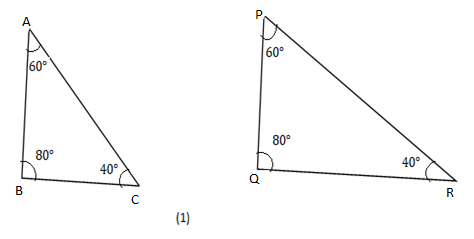
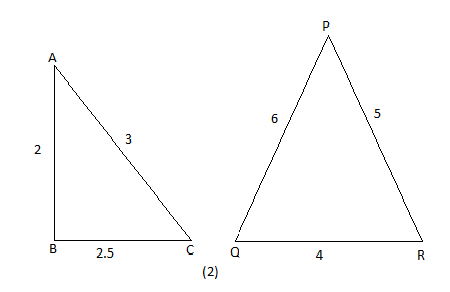
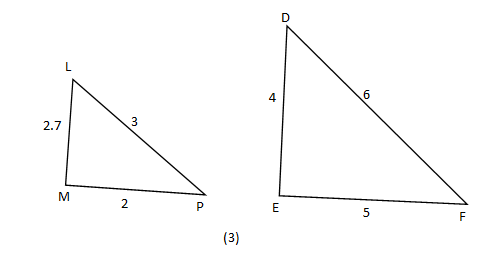
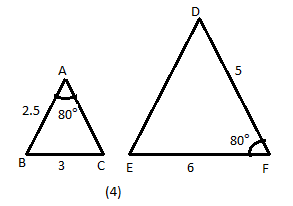
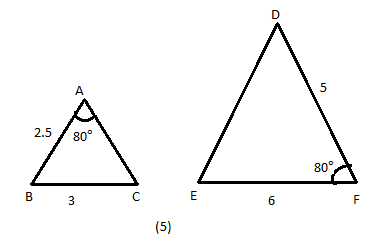
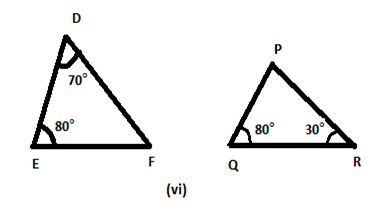






Answer
573.3k+ views
Hint: To solve this variety of triangle, given to use a similar triangle concept. Similar triangles, two figures having the same shape (but not necessarily the same size) are called similar figures.
Two triangles are said to be similar, if
Their corresponding angles are equal and
Their corresponding sides are in the same ratio proportion.
Check the two conditions for all parts \[\left[ {\left( 1 \right){\text{ to }}\left( 6 \right)} \right]\]whether we get similar or not.
Complete step-by-step answer:
1. Given in \[\Delta ABC\] and \[\Delta PQR\]
The corresponding angles are
\[\angle A = \angle P = {60^ \circ }\]
\[\angle B = \angle Q = {80^ \circ }\]
\[\angle C = \angle R = {40^ \circ }\] \[\]
By \[AAA\] similarity, \[\Delta ABC\] and \[\Delta PQR\] is similar
This is \[\Delta ABC \sim \Delta PQR\]
2. In \[\Delta ABC\]and \[\Delta QRP\]
The sides are
\[AB = 2\], \[BC = 2.5\],\[CA = 3\]
\[QR = 4\], \[RP = 5\], \[PQ = 6\]
Thus, \[\Delta ABC\] and \[\Delta QRP\] Corresponding sides are in the same ratio, that is,
\[\dfrac{{AB}}{{QR}} = \dfrac{2}{4} = \dfrac{1}{2}\]
\[\dfrac{{AC}}{{QP}} = \dfrac{3}{6} = \dfrac{1}{2}\]
\[\dfrac{{BC}}{{RP}} = \dfrac{{2.5}}{5} = \dfrac{1}{2}\]
Hence, \[\dfrac{{AB}}{{QR}} = \dfrac{{AC}}{{QP}} = \dfrac{{BC}}{{RP}} = \dfrac{1}{2}\]
By \[SSS\] similarity, \[\Delta ABC\] and \[\Delta QRP\] is similar
This is \[\Delta ABC \sim \Delta QRP\]
3. In \[\Delta MPL\] and \[\Delta EDF\]
The sides are
\[MP = 2, PL = 3, LM = 2.7\]
\[ED = 4, DF = 6, FE = 5\]
Thus,
\[\Delta MPL\] and \[\Delta EDF\] corresponding sides are not in the same ratio, that is,
\[\dfrac{{MP}}{{ED}} = \dfrac{2}{4} = \dfrac{1}{2}\]
\[\dfrac{{PL}}{{DF}} = \dfrac{3}{6} = \dfrac{1}{2}\]
\[\dfrac{{LM}}{{FE}} = \dfrac{{2.7}}{5}\]
Hence, the ratio is not here, the corresponding sides of both the triangles not in the same ratio. And also corresponding angles are not given. Therefore, \[\Delta MPL\] is not similar \[\Delta EDF\].
4. In \[\Delta MNL\] and \[\Delta QPR\]
The corresponding angles are
\[\angle M = {70^ \circ }\]
\[\angle Q = {70^ \circ }\]
Now, the corresponding sides are
\[\dfrac{{MN}}{{QP}} = \dfrac{{2.5}}{5} = \dfrac{1}{2}\]
\[\dfrac{{ML}}{{QR}} = \dfrac{5}{{10}} = \dfrac{1}{2}\]
so, \[\dfrac{{MN}}{{PQ}} = \dfrac{{ML}}{{QR}} = \dfrac{1}{2}\]
By, \[SAS\] Similarity, \[\Delta MNL\] and \[\Delta QPR\] are similar
This is, \[\Delta MNL \sim \Delta QPR\]
5. In \[\Delta ACB\] and \[\Delta FDE\]
The corresponding angles are
\[\angle A = {80^ \circ }\]
\[\angle F = {80^ \circ }\]
The corresponding sides are
\[\dfrac{{AB}}{{FD}} = \dfrac{{2.5}}{5} = \dfrac{1}{2}\]
\[\dfrac{{AC}}{{FE}} = \dfrac{{AC}}{6}\]
So the sides are not corresponding because of \[AC\] is not given
We cannot say the two triangles are under any of \[SAS, SSS, AAA\] similarity.
So, \[\Delta ACB\] and \[\Delta FDE\] are not similar.
6. In\[\Delta DEF\] and \[\Delta PQR\]
Here, the two triangles have only angles, for that we compare to similar triangles for corresponding angles are same or not. For that, There is one angle we need to find either \[\angle F\] or \[\angle P\].
Now, we find \[\angle P\] for \[\Delta PQR\]
The angles are \[\begin{gathered}
\angle Q = {80^ \circ } \\
\angle R = {30^ \circ } \\
\end{gathered} \]
We know that, sum of the angles of the triangle is \[{180^ \circ }\]
\[\angle P + \angle Q + \angle R = {180^ \circ }\]
\[\angle P + {80^ \circ } + {30^ \circ } = {180^ \circ }\]
\[\angle P + {110^ \circ } = {180^ \circ }\]
\[\angle P = {180^ \circ } - {110^ \circ }\]
\[\angle P = {70^ \circ }\]
In \[\Delta DEF\]
\[\begin{gathered}
\angle D = \angle P = {70^ \circ } \\
\angle E = \angle Q = {80^ \circ } \\
\end{gathered} \]
By, \[AA\]similarity \[\Delta DEF\] and \[\Delta PQR\] are similar
Which is, \[\Delta DEF \sim \Delta PQR\]
Hence, we can say \[(i),(ii),(iv),(vi)\] are similar triangles
The similarity criterion using is, \[SAS, SSS, AAA, AA\]
Symbolic form of triangles:
\[\Delta ABC \sim \Delta PQR\],\[\Delta ABC \sim \Delta QRP\],\[\Delta MNL \sim \Delta QPR\],\[\Delta DEF \sim \Delta PQR\]
Note: If two triangles, corresponding angles are equal, then their corresponding sides are same ratio and hence the two triangles are similar (\[AAA\] similarity)
Also, if two angles of triangle are respectively equal to the two angles of another triangle, then the two triangles are similar (\[AA\] similarity)
If two triangles, sides of one triangle are proportional to the sides of the others triangle, then their corresponding angles are equal and hence the two triangles are similar (\[SSS\]similarity)
If one angle of a triangle is equal to one angle of the other triangle and the sides including these angles are proportional, then the two triangles are similar (\[SAS\] similarity)
Here,\[SAS,SSS,AAA,AA\] we are using this are called properties or similarities of similar triangles.
Two triangles are said to be similar, if
Their corresponding angles are equal and
Their corresponding sides are in the same ratio proportion.
Check the two conditions for all parts \[\left[ {\left( 1 \right){\text{ to }}\left( 6 \right)} \right]\]whether we get similar or not.
Complete step-by-step answer:
1. Given in \[\Delta ABC\] and \[\Delta PQR\]
The corresponding angles are
\[\angle A = \angle P = {60^ \circ }\]
\[\angle B = \angle Q = {80^ \circ }\]
\[\angle C = \angle R = {40^ \circ }\] \[\]
By \[AAA\] similarity, \[\Delta ABC\] and \[\Delta PQR\] is similar
This is \[\Delta ABC \sim \Delta PQR\]
2. In \[\Delta ABC\]and \[\Delta QRP\]
The sides are
\[AB = 2\], \[BC = 2.5\],\[CA = 3\]
\[QR = 4\], \[RP = 5\], \[PQ = 6\]
Thus, \[\Delta ABC\] and \[\Delta QRP\] Corresponding sides are in the same ratio, that is,
\[\dfrac{{AB}}{{QR}} = \dfrac{2}{4} = \dfrac{1}{2}\]
\[\dfrac{{AC}}{{QP}} = \dfrac{3}{6} = \dfrac{1}{2}\]
\[\dfrac{{BC}}{{RP}} = \dfrac{{2.5}}{5} = \dfrac{1}{2}\]
Hence, \[\dfrac{{AB}}{{QR}} = \dfrac{{AC}}{{QP}} = \dfrac{{BC}}{{RP}} = \dfrac{1}{2}\]
By \[SSS\] similarity, \[\Delta ABC\] and \[\Delta QRP\] is similar
This is \[\Delta ABC \sim \Delta QRP\]
3. In \[\Delta MPL\] and \[\Delta EDF\]
The sides are
\[MP = 2, PL = 3, LM = 2.7\]
\[ED = 4, DF = 6, FE = 5\]
Thus,
\[\Delta MPL\] and \[\Delta EDF\] corresponding sides are not in the same ratio, that is,
\[\dfrac{{MP}}{{ED}} = \dfrac{2}{4} = \dfrac{1}{2}\]
\[\dfrac{{PL}}{{DF}} = \dfrac{3}{6} = \dfrac{1}{2}\]
\[\dfrac{{LM}}{{FE}} = \dfrac{{2.7}}{5}\]
Hence, the ratio is not here, the corresponding sides of both the triangles not in the same ratio. And also corresponding angles are not given. Therefore, \[\Delta MPL\] is not similar \[\Delta EDF\].
4. In \[\Delta MNL\] and \[\Delta QPR\]
The corresponding angles are
\[\angle M = {70^ \circ }\]
\[\angle Q = {70^ \circ }\]
Now, the corresponding sides are
\[\dfrac{{MN}}{{QP}} = \dfrac{{2.5}}{5} = \dfrac{1}{2}\]
\[\dfrac{{ML}}{{QR}} = \dfrac{5}{{10}} = \dfrac{1}{2}\]
so, \[\dfrac{{MN}}{{PQ}} = \dfrac{{ML}}{{QR}} = \dfrac{1}{2}\]
By, \[SAS\] Similarity, \[\Delta MNL\] and \[\Delta QPR\] are similar
This is, \[\Delta MNL \sim \Delta QPR\]
5. In \[\Delta ACB\] and \[\Delta FDE\]
The corresponding angles are
\[\angle A = {80^ \circ }\]
\[\angle F = {80^ \circ }\]
The corresponding sides are
\[\dfrac{{AB}}{{FD}} = \dfrac{{2.5}}{5} = \dfrac{1}{2}\]
\[\dfrac{{AC}}{{FE}} = \dfrac{{AC}}{6}\]
So the sides are not corresponding because of \[AC\] is not given
We cannot say the two triangles are under any of \[SAS, SSS, AAA\] similarity.
So, \[\Delta ACB\] and \[\Delta FDE\] are not similar.
6. In\[\Delta DEF\] and \[\Delta PQR\]
Here, the two triangles have only angles, for that we compare to similar triangles for corresponding angles are same or not. For that, There is one angle we need to find either \[\angle F\] or \[\angle P\].
Now, we find \[\angle P\] for \[\Delta PQR\]
The angles are \[\begin{gathered}
\angle Q = {80^ \circ } \\
\angle R = {30^ \circ } \\
\end{gathered} \]
We know that, sum of the angles of the triangle is \[{180^ \circ }\]
\[\angle P + \angle Q + \angle R = {180^ \circ }\]
\[\angle P + {80^ \circ } + {30^ \circ } = {180^ \circ }\]
\[\angle P + {110^ \circ } = {180^ \circ }\]
\[\angle P = {180^ \circ } - {110^ \circ }\]
\[\angle P = {70^ \circ }\]
In \[\Delta DEF\]
\[\begin{gathered}
\angle D = \angle P = {70^ \circ } \\
\angle E = \angle Q = {80^ \circ } \\
\end{gathered} \]
By, \[AA\]similarity \[\Delta DEF\] and \[\Delta PQR\] are similar
Which is, \[\Delta DEF \sim \Delta PQR\]
Hence, we can say \[(i),(ii),(iv),(vi)\] are similar triangles
The similarity criterion using is, \[SAS, SSS, AAA, AA\]
Symbolic form of triangles:
\[\Delta ABC \sim \Delta PQR\],\[\Delta ABC \sim \Delta QRP\],\[\Delta MNL \sim \Delta QPR\],\[\Delta DEF \sim \Delta PQR\]
Note: If two triangles, corresponding angles are equal, then their corresponding sides are same ratio and hence the two triangles are similar (\[AAA\] similarity)
Also, if two angles of triangle are respectively equal to the two angles of another triangle, then the two triangles are similar (\[AA\] similarity)
If two triangles, sides of one triangle are proportional to the sides of the others triangle, then their corresponding angles are equal and hence the two triangles are similar (\[SSS\]similarity)
If one angle of a triangle is equal to one angle of the other triangle and the sides including these angles are proportional, then the two triangles are similar (\[SAS\] similarity)
Here,\[SAS,SSS,AAA,AA\] we are using this are called properties or similarities of similar triangles.
Recently Updated Pages
Two men on either side of the cliff 90m height observe class 10 maths CBSE

What happens to glucose which enters nephron along class 10 biology CBSE

Cutting of the Chinese melon means A The business and class 10 social science CBSE

Write a dialogue with at least ten utterances between class 10 english CBSE

Show an aquatic food chain using the following organisms class 10 biology CBSE

A circle is inscribed in an equilateral triangle and class 10 maths CBSE

Trending doubts
Why is there a time difference of about 5 hours between class 10 social science CBSE

Write a letter to the principal requesting him to grant class 10 english CBSE

What is the median of the first 10 natural numbers class 10 maths CBSE

The Equation xxx + 2 is Satisfied when x is Equal to Class 10 Maths

Which of the following does not have a fundamental class 10 physics CBSE

State and prove converse of BPT Basic Proportionality class 10 maths CBSE




